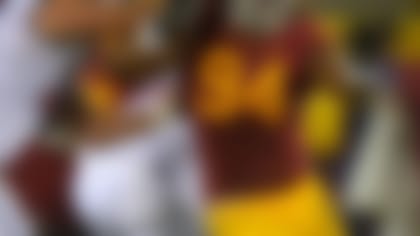We continue our quick-hit position overviews for the 2015 NFL Draft with wide receivers and tight ends.
Positional overviews: QBs | RBs | Interior DLs | Edge rushers
Last year's draft was an incredibly good one for wide receivers, with five going in the first round and another seven in the second round. All five taken in the first round had, at the least, solid rookie seasons; three (Odell Beckham Jr., Kelvin Benjamin and Mike Evans) had 1,000-yard seasons, and two (Beckham and Evans) had 12 TD receptions apiece. In addition, two second-rounders (Jarvis Landry and Jordan Matthews) had at least 67 receptions and at least 758 receiving yards apiece.
This year's receiver class isn't quite as deep, but conventional wisdom has five going in the first round for the second year in a row and there could be as many as six wide receivers who go in the initial round. The last time at least five wide receivers went in the first round in back-to-back drafts was 2004 and '05 (there were seven in '04 and six in '05).
This year's tight end class, though, is considered a mediocre one. This looks as if it will be the first draft in three years without a tight end being selected in the first round. Still, while there isn't that much at the top in this tight end class, there are some intriguing later-round prospects at the position.
Here's a quickie look at wide receivers and tight ends in this draft.
Wide receiver
Teams with greatest need (in draft order): Oakland (picks 4th), St. Louis (10th), New Orleans (13th and 31st), Miami (14th), Houston (16th), Philadelphia (20th), Cincinnati (21st), Carolina (25th), Baltimore (26th), New England (32nd), Seattle (63rd).
Mike Mayock's top 5 at the position: 1. West Virginia's Kevin White; 2. Alabama's Amari Cooper; 3. Louisville's DeVante Parker; 4. UCF's Breshad Perriman; T-5. Oklahoma's Dorial Green-Beckham; T-5. USC's Nelson Agholor.
Biggest upside: West Virginia's Kevin White. Depending upon the analyst, White is either the No. 1 or 2 wide receiver in this draft. But almost all agree he has the biggest upside among the receivers. He isn't as polished as Alabama's Amari Cooper, but White is two inches taller and a bit faster, and the thought is that once he polishes the rough edges, he can be a Pro Bowl-caliber No. 1 receiver. He was productive in WVU's version of the spread, which is an offshoot of Mike Leach's "Air Raid" attack. But White's size, strength and speed -- in short, he has rare physical attributes -- give him the opportunity to develop from a big-time spread receiver into a big-time pro-style receiver.
Most underrated: Florida State's Rashad Greene. Miami WR Phillip Dorsett, his former high school teammate at powerhouse Fort Lauderdale St. Thomas Aquinas, is getting a lot of pre-draft attention, but there hasn't been much for Greene (5-11, 182). Dorsett is much faster, but Greene is the more polished receiver; he also was far more productive (Dorsett had 121 career catches; Greene had 99 as a senior alone, and 270 in his career). While he might fit best as a slot receiver, Greene spent most of his FSU career outside and should be able to play there in the NFL, too. He lacks bulk and actually looks small. But he has excellent hands and is smooth in and out of his cuts. While he's not an elite deep threat, he can get deep on occasion, and he also has the ability to make defenders miss. He likely won't be a No. 1 guy at the next level, but he certainly can be a consistent and productive No. 2 guy in the right system.
Most overrated: Auburn's Sammie Coates. Coates has excellent speed and athleticism for a guy his size (6-1, 212), and by all accounts, he is a great person. But he also is a receiver, and receivers are supposed to catch the ball. That was an issue for Coates. He has the ability to get deep and occasionally make a spectacular catch. But he's also liable to drop one (or two or three) right in his hands. He is going to get his chance at the next level, and he certainly has the potential to be a productive -- and big-play -- receiver. But he must develop some consistency and quit dropping what should be easy receptions.
Biggest sleeper: Texas A&M-Commerce's Vernon Johnson. Johnson (6-1, 190) is one of two wide receivers from A&M-Commerce who could be (should be?) drafted; the other is Ricky Collins (6-0, 200). Johnson is a former JC transfer who played two seasons at Division II A&M-Commerce. While Johnson isn't a blazer, he has good size, is dangerous after the catch and has excellent acceleration. He obviously hasn't played against high-level competition, and he needs to show he can handle press coverage. But he has the ability to get deep and also possesses good hands. Johnson also has the ability to be a kick returner, which adds to his value. (A&M-Commerce is located about 70 miles northeast of Dallas and hasn't had a player drafted since 2000. The school used to be known as East Texas State; among its alums are Harvey Martin, Dwight White and Wade Wilson.)
Better pro than college player: Central Arkansas' Dezmin Lewis. Lewis intrigues a number of teams. His size (6-4, 214) is eye-catching, and while he lacks top-end speed, he is not slow. He looked polished in his combine workout, which impressed teams. He did not play against good competition in college and basically used his size to overpower FCS defensive backs; his ability to handle press coverage is a question. He is raw and needs time to develop, especially as a route runner. Again, though, Lewis is a big guy who certainly has the skill set and measurables to develop into a competent NFL receiver.
Top small-school prospect: William & Mary's Tre McBride. McBride was a three-year starter for the Tribe, a FCS program, finishing his career with 196 receptions for 2,753 yards and 19 touchdowns. McBride (6-0, 210) has good size and speed (4.41 in the 40 at the combine, with a tremendous unofficial 10-yard split of 1.51 seconds). He tracks the ball well and moves easily in and out of cuts. He potentially could play outside or in the slot; his size would be interesting when used in the slot. McBride (his given name is Douglas McArthur McBride III) seems a lock to be the first William & Mary wide receiver drafted since 1973, when David Knight was an 11th-round pick by the New York Jets.
First-round grades (in order): Cooper, White, Perriman, Parker and Arizona State's Jaelen Strong.
Tight end
Teams with greatest need (in draft order): Atlanta (picks 8th); Cleveland (12th and 19th), Pittsburgh (22nd), Denver (28th), Buffalo (50th).
Mike Mayock's top 5 at the position: 1. Minnesota's Maxx Williams; 2. Miami's Clive Walford; 3. Oklahoma's Blake Bell; 4. Rutgers' Tyler Kroft; 5. Ohio State's Jeff Heuerman.
Biggest upside: Miami's Clive Walford. Minnesota's Maxx Williams generally is considered the best tight end in this class and the only player at the position with a chance to go in the first round. But Walford is the most explosive tight end in this class, and that gives him the most upside. He only played one year of varsity football in high school, and he still is learning the nuances of the position. But he has good size (6-4, 251) and has the speed to get deep. He is a willing blocker and has improved in that facet of his game. He has had consistency issues, but that negative aspect showed signs of going away in 2014. Miami coaches moved him around -- he saw time as a "regular" tight end, in the slot and in an H-back role -- and that versatility adds to his value.
Most underrated: Oklahoma's Blake Bell. Bell began his OU career at quarterback, then moved to tight end this season, which means he still is learning the position, but he has an intriguing upside. Bell (6-6, 252) has good size, carries his weight well and looks almost lean. As a former quarterback, Bell should be able to quickly grasp an NFL offense, and for a guy who has played tight end less than a year, he looks at ease when running routes and has good hands. Bell, from Wichita, Kan., was a consensus national top-75 player and the No. 1 dual-threat quarterback in the 2010 recruiting class. He redshirted that fall, then saw time as a backup quarterback in 2011 and '12, becoming known as the "Belldozer" for his brutish running style in short-yardage and goal-line situations. He became the starter early in the 2013 season but missed time late in the season with an injury, and coaches made the decision to move him to tight end in January 2014. He has good bloodlines: His dad and uncle both played defensive end in the NFL.
Most overrated: Florida State's Nick O'Leary. O'Leary won the Mackey Award as the nation's top tight end in 2014, but he's not necessarily a top NFL prospect. O'Leary (6-3, 252) has good hands, knows how to get open and was used in a variety of roles by FSU coaches. But he lacks speed and can't get deep; in addition, while a willing blocker, that facet of his game isn't a strong suit, either. Still, his receiving skills are impressive, and he could end up as H-back. But to expect him to go from Mackey Award winner to NFL star is asking way too much.
Biggest sleeper: Illinois State's James O'Shaughnessy. Southern Illinois' MyCole Pruitt, who plays in the same league as O'Shaughnessy (Missouri Valley), is the FCS tight end who has received the most pre-draft notice, but O'Shaughnessy (6-4, 245) quietly is moving up draft boards. He was a three-year starter at Illinois State, which lost in the FCS title game to North Dakota State this past season. He had 29 receptions in 2014 and nine went for TDs. He is a good athlete and possesses the ability to get deep. While a willing blocker (he had to be for the Redbirds, who ran the ball 63 percent of the time in 2014), he needs to add strength and bulk to become productive in that facet at the next level. But it's his receiving skills that are the big selling point.
Better pro than college player: South Alabama's Wes Saxton. Saxton was an underutilized weapon for the Jaguars. He had 20 receptions and no TDs in 2014; he had 50 receptions as a junior in 2013, but he didn't have a TD catch that season, either. Still, Saxton (6-3, 248) appears to have the necessary skill-set to play tight end in today's NFL; he can be moved around the formation -- he played a lot of H-back as a senior -- and some teams really like him as a slot tight end. Saxton can run and is a solid athlete, though he does need to improve his concentration level and skills as a blocker. He played high school ball with Jameis Winston in Hueytown, Ala., and is a cousin to former NFL RB Tony Nathan.
Top small-school prospect: O'Shaughnessy. We talked about O'Shaughnessy "quietly moving up draft boards" in an earlier category; he has moved up enough in the eyes of NFL Media analyst Lance Zierlein that he now is the highest-rated non-FBS tight end in this draft. Pruitt (6-2, 251) -- who went to the same high school (Kirkwood, in the St. Louis suburbs) as Jeremy Maclin -- was the more decorated of the two, finishing his career with a conference-record 211 receptions. But O'Shaughnessy is the better athlete and has more of an upside.
First-round grades (in order): None.
Mike Huguenin can be reached at mike.huguenin@nfl.com. You also can follow him on Twitter @MikeHuguenin.










